SNLS316G September 2009 – December 2015 DS90UR907Q-Q1
PRODUCTION DATA.
- 1 Features
- 2 Applications
- 3 Description
- 4 Revision History
- 5 Pin Configuration and Functions
-
6 Specifications
- 6.1 Absolute Maximum Ratings
- 6.2 ESD Ratings—JEDEC
- 6.3 ESD Ratings—IEC and ISO
- 6.4 Recommended Operating Conditions
- 6.5 Thermal Information
- 6.6 DC Electrical Characteristics
- 6.7 Recommended Timing for the Serial Control Bus
- 6.8 Switching Characteristics
- 6.9 DC and AC Serial Control Bus Characteristics
- 6.10 Typical Characteristics
-
7 Detailed Description
- 7.1 Overview
- 7.2 Functional Block Diagram
- 7.3 Feature Description
- 7.4 Device Functional Modes
- 7.5 Programming
- 8 Application and Implementation
- 9 Power Supply Recommendations
- 10Layout
- 11Device and Documentation Support
- 12Mechanical, Packaging, and Orderable Information
Package Options
Mechanical Data (Package|Pins)
- NJK|36
Thermal pad, mechanical data (Package|Pins)
Orderable Information
6 Specifications
6.1 Absolute Maximum Ratings
over operating free-air temperature range (unless otherwise noted)(1)(9)(1) Stresses beyond those listed under Absolute Maximum Ratings may cause permanent damage to the device. These are stress ratings only, which do not imply functional operation of the device at these or any other conditions beyond those indicated under Recommended Operating Conditions. Exposure to absolute-maximum-rated conditions for extended periods may affect device reliability.
6.2 ESD Ratings—JEDEC
| VALUE | UNIT | |||
|---|---|---|---|---|
| V(ESD) | Electrostatic discharge | Human-body model (HBM), per AEC Q100-002(1) | ±8000 | V |
| Charged-device model (CDM), per AEC Q100-011 | ±1250 | |||
| Machine model | ±250 | |||
(1) AEC Q100-002 indicates that HBM stressing shall be in accordance with the ANSI/ESDA/JEDEC JS-001 specification.
6.3 ESD Ratings—IEC and ISO
| VALUE | UNIT | ||||
|---|---|---|---|---|---|
| V(ESD) | Electrostatic discharge | RD = 330 Ω, CS = 150 pF | IEC, powered-up only contact discharge (RIN+, RIN−) | ≥±6000 | V |
| IEC, powered-up only air-gap discharge (RIN+, RIN−) | ≥±30000 | ||||
| RD = 330 Ω, CS = 150 and 330 pF | ISO10605 contact discharge (RIN+, RIN−) | ≥±8000 | V | ||
| ISO10605 air-gap discharge (RIN+, RIN−) | ≥±15000 | ||||
| RD = 2 kΩ, CS = 150 and 330 pF | ISO10605 contact discharge (RIN+, RIN−) | ≥±8000 | V | ||
| ISO10605 air-gap discharge (RIN+, RIN−) | ≥±15000 | ||||
6.4 Recommended Operating Conditions
| MIN | NOM | MAX | UNIT | |
|---|---|---|---|---|
| Supply Voltage (VDDn) | 1.71 | 1.8 | 1.89 | V |
| LVCMOS Supply Voltage (VDDIO) | 1.71 | 1.8 | 1.89 | V |
| OR | ||||
| LVCMOS Supply Voltage (VDDIO) | 3 | 3.3 | 3.6 | V |
| Operating Free Air Temperature (TA) | −40 | 25 | 105 | °C |
| RxCLKIN Frequency | 5 | 65 | MHz | |
| Supply Noise(6) | 100 | mVP-P |
6.5 Thermal Information
| THERMAL METRIC(1) | DS90UR907Q-Q1 | UNIT | |
|---|---|---|---|
| NJK (WQFN) | |||
| 36 PINS | |||
| RθJA | Junction-to-ambient thermal resistance | 33.8 | °C/W |
| RθJC(top) | Junction-to-case (top) thermal resistance | 15.8 | °C/W |
| RθJB | Junction-to-board thermal resistance | 7.2 | °C/W |
| ψJT | Junction-to-top characterization parameter | 0.2 | °C/W |
| ψJB | Junction-to-board characterization parameter | 7.1 | °C/W |
| RθJC(bot) | Junction-to-case (bottom) thermal resistance | 2.6 | °C/W |
(1) For more information about traditional and new thermal metrics, see the Semiconductor and IC Package Thermal Metrics application report, SPRA953.
6.6 DC Electrical Characteristics
Over recommended operating supply and temperature ranges unless otherwise specified.(1)(2)(3)| PARAMETER | TEST CONDITIONS | PIN/FREQ. | MIN | TYP | MAX | UNIT | ||
|---|---|---|---|---|---|---|---|---|
| LVCMOS INPUT DC SPECIFICATIONS | ||||||||
| VIH | High Level Input Voltage | VDDIO = 3 to 3.6 V | PDB, VODSEL, MAPSEL, CONFIG[1:0],BISTEN |
2.2 | VDDIO | V | ||
| VDDIO = 1.71 to 1.89 V | 0.65* VDDIO | VDDIO | ||||||
| VIL | Low Level Input Voltage | VDDIO = 3 to 3.6 V | GND | 0.8 | V | |||
| VDDIO = 1.71 to 1.89 V | GND | 0.35* VDDIO | ||||||
| IIN | Input Current | VIN = 0 V or VDDIO | VDDIO = 3 to 3.6 V |
–15 | ±1 | 15 | μA | |
| VDDIO = 1.7 to 1.89 V |
–15 | ±1 | 15 | |||||
| FPD-LINK LVDS RECEIVER DC SPECIFICATIONS | ||||||||
| VTH | Differential Threshold High Voltage | VCM = 1.2 V, Figure 1 | RxIN[3:0]+/-, RxCLKIN+/-, | 100 | mV | |||
| VTL | Differential Threshold Low Voltage | –100 | ||||||
| |VID| | Differential Input Voltage Swing | 200 | 600 | mV | ||||
| VCM | Common Mode Voltage | VDDIO = 3.3 V | 0 | 1.2 | 2.4 | V | ||
| VDDIO = 1.8 V | 0 | 1.2 | 1.55 | |||||
| IIN | Input Current | −15 | ±1 | 15 | μA | |||
| FPD-LINK II LVDS DRIVER DC SPECIFICATIONS | ||||||||
| VOD | Differential Output Voltage | RL = 100 Ω, De-Emph = disabled, Figure 3 |
VODSEL = 0 | DOUT+, DOUT- | ±225 | ±300 | ±375 | mV |
| VODSEL = 1 | ±350 | ±450 | ±550 | |||||
| VODp-p | Differential Output Voltage (DOUT+) – (DOUT-) |
VODSEL = 0 | 600 | mVp-p | ||||
| VODSEL = 1 | 900 | mVp-p | ||||||
| ΔVOD | Output Voltage Unbalance | RL = 100 Ω, De-Emph = disabled, VODSEL = L | 1 | 50 | mV | |||
| VOS | Offset Voltage – Single-ended At TP A and B, Figure 2 |
RL = 100 Ω, De-Emph = disabled |
VODSEL = 0 | 1.65 | V | |||
| VODSEL = 1 | 1.575 | V | ||||||
| ΔVOS | Offset Voltage Unbalance Single-ended At TP A and B, Figure 2 |
RL = 100 Ω, De-Emph = disabled | 1 | mV | ||||
| IOS | Output Short-Circuit Current | DOUT± = 0 V, De-Emph = disabled |
VODSEL = 0 | –35 | mA | |||
| RT | Internal Termination Resistor | 80 | 120 | Ω | ||||
| SUPPLY CURRENT | ||||||||
| IDDT1 | Supply Current (includes load current) RL = 100 Ω, f = 65 MHz |
Checker Board Pattern, De-Emph = 3 kΩ, VODSEL = H, Figure 10 |
VDD= 1.89 V | All VDD pins | 80 | 90 | mA | |
| IDDIOT1 | VDDIO= 1.89 V | VDDIO | 3 | 5 | mA | |||
| VDDIO = 3.6 V | 10 | 13 | mA | |||||
| IDDT2 | Checker Board Pattern, De-Emph = 6 kΩ, VODSEL = L, Figure 10 |
VDD= 1.89 V | All VDD pins | 75 | 85 | mA | ||
| IDDIOT2 | VDDIO= 1.89 V | VDDIO | 3 | 5 | mA | |||
| VDDIO = 3.6 V | 10 | 13 | mA | |||||
| IDDZ | Supply Current Power Down | PDB = 0 V , (All other LVCMOS Inputs = 0 V) | VDD= 1.89 V | All VDD pins | 60 | 1000 | µA | |
| IDDIOZ | VDDIO= 1.89 V | VDDIO | 0.5 | 10 | µA | |||
| VDDIO = 3.6 V | 1 | 30 | µA | |||||
6.7 Recommended Timing for the Serial Control Bus
Over 3.3-V supply and temperature ranges unless otherwise specified.| MIN | NOM | MAX | Units | |||
|---|---|---|---|---|---|---|
| fSCL | SCL Clock Frequency | Standard Mode | 0 | 100 | kHz | |
| Fast Mode | 0 | 400 | ||||
| tLOW | SCL Low Period | Standard Mode | 4.7 | us | ||
| Fast Mode | 1.3 | |||||
| tHIGH | SCL High Period | Standard Mode | 4 | us | ||
| Fast Mode | 0.6 | |||||
| tHD;STA | Hold time for a start or a repeated start condition, Figure 12 |
Standard Mode | 4 | us | ||
| Fast Mode | 0.6 | |||||
| tSU:STA | Set Up time for a start or a repeated start condition, Figure 12 |
Standard Mode | 4.7 | us | ||
| Fast Mode | 0.6 | |||||
| tHD;DAT | Data Hold Time, Figure 12 |
Standard Mode | 0 | 3.45 | us | |
| Fast Mode | 0 | 0.9 | ||||
| tSU;DAT | Data Set Up Time, Figure 12 |
Standard Mode | 250 | ns | ||
| Fast Mode | 100 | |||||
| tSU;STO | Set Up Time for STOP Condition, Figure 12 | Standard Mode | 4 | us | ||
| Fast Mode | 0.6 | |||||
| tBUF | Bus Free Time Between STOP and START, Figure 12 |
Standard Mode | 4.7 | us | ||
| Fast Mode | 1.3 | |||||
| tr | SCL and SDA Rise Time, Figure 12 |
Standard Mode | 1000 | ns | ||
| Fast Mode | 300 | |||||
| tf | SCL and SDA Fall Time, Figure 12 |
Standard Mode | 300 | ns | ||
| Fast mode | 300 | |||||
6.8 Switching Characteristics
Over recommended operating supply and temperature ranges unless otherwise specified.| PARAMETER | TEST CONDITIONS | MIN | TYP | MAX | UNIT | |
|---|---|---|---|---|---|---|
| FPD-LINK LVDS INPUT | ||||||
| tRSP0 | Receiver Strobe Position-bit 0 | RxCLKIN = 65 MHz, RxIN[3:0] Figure 5 |
0.66 | 1.1 | 1.54 | ns |
| tRSP1 | Receiver Strobe Position-bit 1 | 2.86 | 3.3 | 3.74 | ns | |
| tRSP2 | Receiver Strobe Position-bit 2 | 5.05 | 5.5 | 5.93 | ns | |
| tRSP3 | Receiver Strobe Position-bit 3 | 7.25 | 7.7 | 8.13 | ns | |
| tRSP4 | Receiver Strobe Position-bit 4 | 9.45 | 9.90 | 10.33 | ns | |
| tRSP5 | Receiver Strobe Position-bit 5 | 11.65 | 12.1 | 12.53 | ns | |
| tRSP6 | Receiver Strobe Position-bit 6 | 13.85 | 14.30 | 14.73 | ns | |
| FPD-LINK II LVDS OUTPUT | ||||||
| tHLT | Output Low-to-High Transition Time, Figure 4 | RL = 100 Ω, De-Emphasis = disabled, VODSEL = 0 | 200 | ps | ||
| RL = 100 Ω, De-Emphasis = disabled, VODSEL = 1 | 200 | |||||
| tHLT | Output High-to-Low Transition Time, Figure 4 | RL = 100 Ω, De-Emphasis = disabled, VODSEL = 0 | 200 | ps | ||
| RL = 100 Ω, De-Emphasis = disabled, VODSEL = 1 | 200 | |||||
| tXZD | Ouput Active to OFF Delay, Figure 7 | 5 | 15 | ns | ||
| tPLD | PLL Lock Time, Figure 6 | RL = 100 Ω(4) | 1.5 | 10 | ms | |
| tSD | Delay - Latency, Figure 8 | RL = 100 Ω | 140*T | 145*T | ns | |
| tDJIT | Output Total Jitter, Figure 9 |
RL = 100 Ω, De-Emphasis = disabled, RANDOM pattern, RxCLKIN = 43 and 65 MHz(5) |
0.26 | UI | ||
| λSTXBW | Jitter Transfer Function –3-dB Bandwidth(7) (8) |
RxCLKIN = 43 MHz | 2.2 | MHz | ||
| RxCLKIN = 65 MHz | 3 | |||||
| δSTX | Jitter Transfer Function Peaking(7)(8) |
RxCLKIN = 43 MHz | 1 | dB | ||
| RxCLKIN = 65 MHz | 1 | |||||
6.9 DC and AC Serial Control Bus Characteristics
Over 3.3-V supply and temperature ranges unless otherwise specified.| PARAMETER | TEST CONDITIONS | MIN | TYP | MAX | UNIT | |
|---|---|---|---|---|---|---|
| VIH | Input High Level | SDA and SCL | 0.7* VDDIO |
VDDIO | V | |
| VIL | Input Low Level Voltage | SDA and SCL | GND | 0.3* VDDIO |
V | |
| VHY | Input Hysteresis | >50 | mV | |||
| VOL | SDA, IOL = 1.25 mA | 0 | 0.36 | V | ||
| Iin | SDA or SCL, Vin = VDDIO or GND | –10 | 10 | µA | ||
| tR | SDA RiseTime – READ | SDA, RPU = 10 kΩ, Cb ≤ 400 pF, Figure 12 | 430 | ns | ||
| tF | SDA Fall Time – READ | 20 | ns | |||
| tSU;DAT | Set Up Time — READ | See Figure 12 | 560 | ns | ||
| tHD;DAT | Hold Up Time — READ | See Figure 12 | 615 | ns | ||
| tSP | Input Filter | 50 | ns | |||
| Cin | Input Capacitance | SDA or SCL | <5 | pF | ||
(1) The Electrical Characteristics tables list ensured specifications under the listed Recommended Operating Conditions except as otherwise modified or specified by the Electrical Characteristics Conditions and/or Notes. Typical specifications are estimations only and are not ensured.
(2) Typical values represent most likely parametric norms at VDD = 3.3 V, Ta = 25°C, and at the Recommended Operation Conditions at the time of product characterization and are not ensured.
(3) Current into device pins is defined as positive. Current out of a device pin is defined as negative. Voltages are referenced to ground except VOD, ΔVOD, VTH and VTL which are differential voltages.
(4) tPLD is the time required by the device to obtain lock when exiting power-down state with an active RxCLKIN.
(5) UI – Unit Interval is equivalent to one serialized data bit width (1UI = 1 / 28*RxCLKIN). The UI scales with RxCLKIN frequency.
(6) Supply noise testing was done with minimum capacitors on the PCB. A sinusoidal signal is AC coupled to the VDDn (1.8 V) supply with amplitude = 100 mVp-p measured at the device VDDn pins. Bit error rate testing of input to the Ser and output of the Des with 10 meter cable shows no error when the noise frequency on the Ser is less than 750 kHz. The Des on the other hand shows no error when the noise frequency is less than 400 kHz.
(7) Specification is ensured by characterization and is not tested in production.
(8) Specification is ensured by design and is not tested in production.
(9) If Military/Aerospace specified devices are required, contact the Texas Instruments Sales Office/ Distributors for availability and specifications.
 Figure 1. FPD-Link DC VTH/VTL Definition
Figure 1. FPD-Link DC VTH/VTL Definition
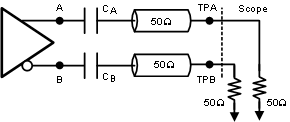 Figure 2. Output Test Circuit
Figure 2. Output Test Circuit
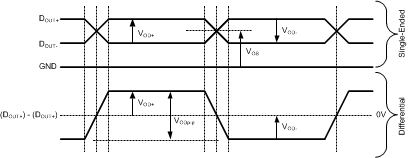 Figure 3. Output Waveforms
Figure 3. Output Waveforms
 Figure 4. Output Transition Times
Figure 4. Output Transition Times
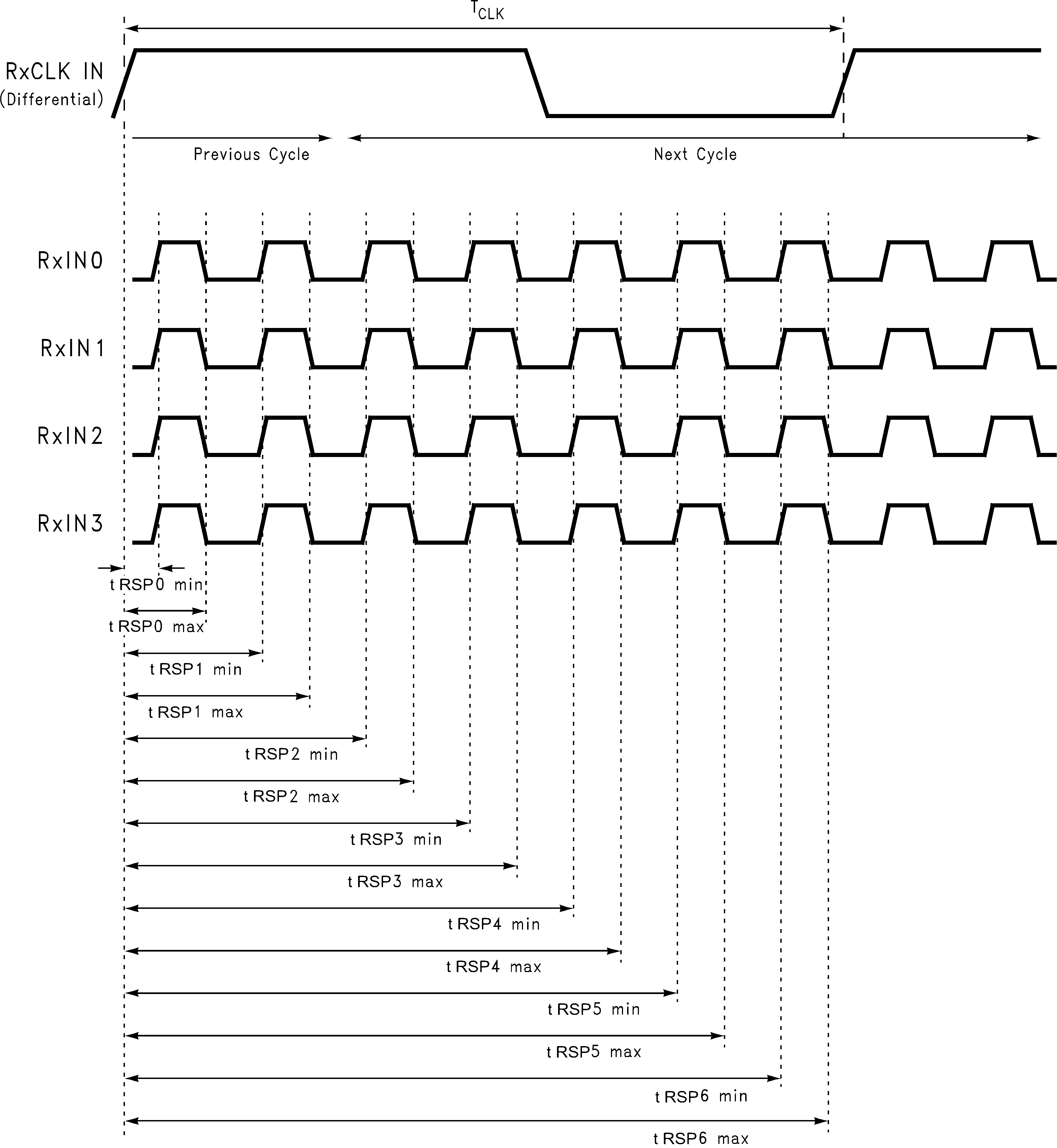 Figure 5. RSP (Receiver Strobe Position)
Figure 5. RSP (Receiver Strobe Position)
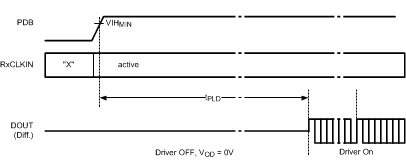 Figure 6. Lock Time
Figure 6. Lock Time
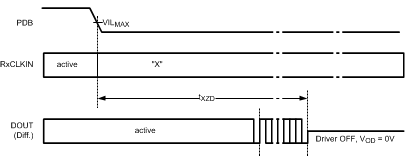 Figure 7. Disable Time
Figure 7. Disable Time
 Figure 8. Latency Delay
Figure 8. Latency Delay
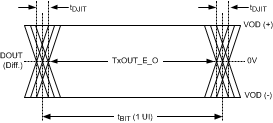 Figure 9. Output Jitter
Figure 9. Output Jitter
 Figure 10. Checkerboard Data Pattern
Figure 10. Checkerboard Data Pattern
 Figure 11. BIST Pass Waveform
Figure 11. BIST Pass Waveform
 Figure 12. Serial Control Bus Timing Diagram
Figure 12. Serial Control Bus Timing Diagram
6.10 Typical Characteristics
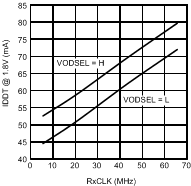 Figure 13. Typical IDDT (1.8-V Supply) Current as a Function of RxCLK
Figure 13. Typical IDDT (1.8-V Supply) Current as a Function of RxCLK